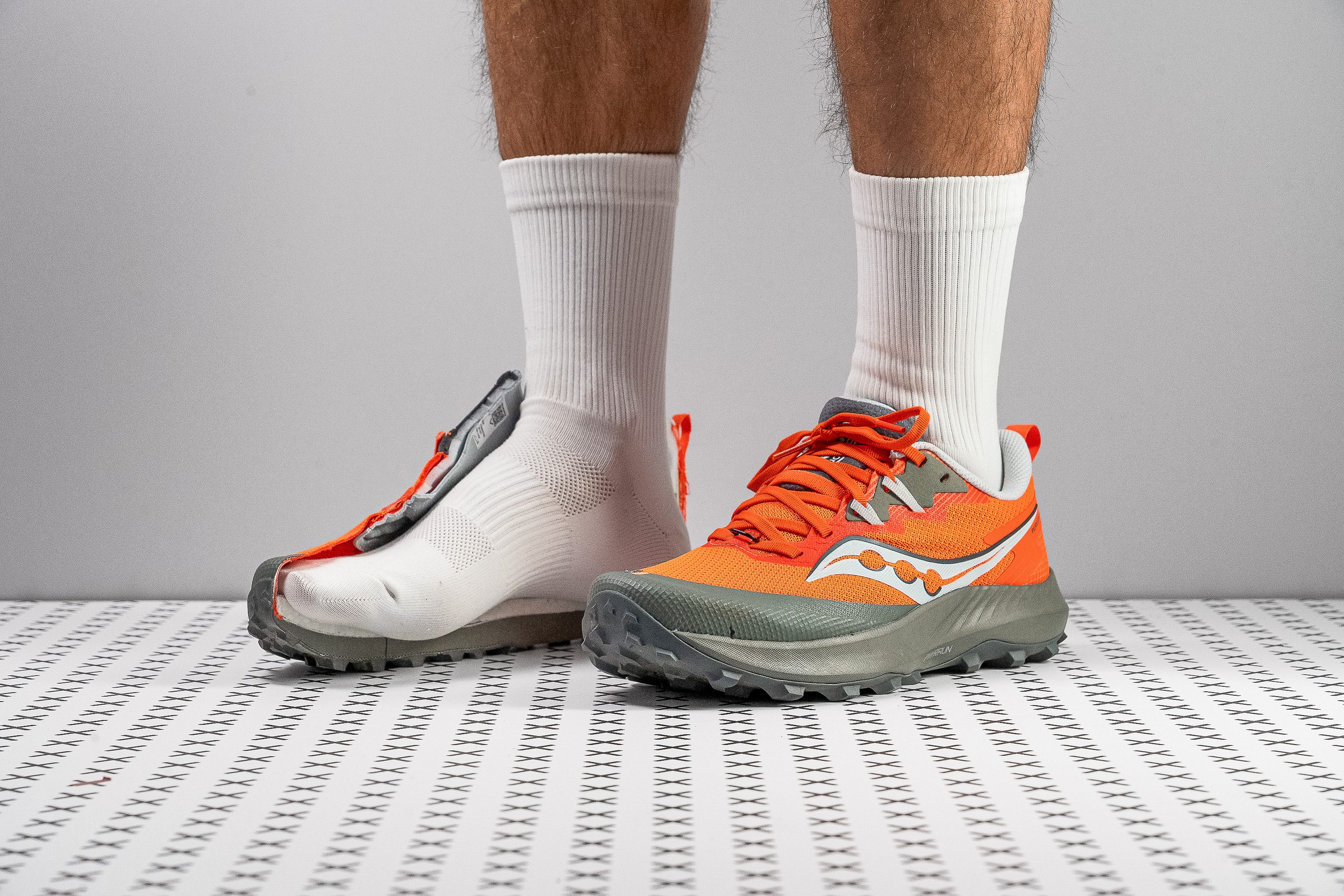Our verdict
Pros
- Natural running feel
- Superb value at just $140
- Flexible and comfortable
- Heel security
- Plusher tongue
- Cushioned insole
- Rock plate
- Highly versatile
Cons
- Not for ultras
- Somewhat firm
Audience verdict
- Top 25% in trail running shoes
- Top 27% in low drop running shoes
Comparison
The most similar running shoes compared
+ + Add a shoe | |||||
|---|---|---|---|---|---|
| Audience score | 88 Great! | 77 Decent! | 90 Superb! | 89 Great! | |
| Price | £135 | £130 | £135 | £140 | |
| Trail terrain | ModerateTechnical | LightModerate | ModerateTechnical | ModerateTechnical | |
| Shock absorption | Moderate | Moderate | - | Low | |
| Energy return | Moderate | Moderate | - | Low | |
| Arch support | Neutral | Neutral | Neutral | Neutral | |
| Weight lab Weight brand | 9.4 oz / 266g 9.4 oz / 267g | 9.4 oz / 266g 9.7 oz / 275g | 10.2 oz / 288g 10.1 oz / 286g | 9.6 oz / 271g 10.2 oz / 290g | |
| Drop lab Drop brand | 2.2 mm 4.0 mm | 3.7 mm 4.0 mm | 4.4 mm 3.0 mm | 3.0 mm 4.0 mm | |
| Strike pattern | Mid/forefoot | Mid/forefoot | Mid/forefoot | Mid/forefoot | |
| Size | True to size | True to size | True to size | True to size | |
| Midsole softness | Balanced | Soft | Soft | Soft | |
| Difference in midsole softness in cold | Small | Small | Normal | Normal | |
| Plate | Rock plate | Rock plate | ✗ | ✗ | |
| Toebox durability | Decent | Good | Very good | Good | |
| Heel padding durability | Decent | Decent | Decent | Decent | |
| Outsole durability | Good | Good | - | Good | |
| Breathability | Moderate | Moderate | Moderate | Warm | |
| Width / fit | Wide | Medium | Medium | Medium | |
| Toebox width | Medium | Narrow | Medium | Medium | |
| Stiffness | Moderate | Moderate | Stiff | Moderate | |
| Torsional rigidity | Moderate | Flexible | Moderate | Stiff | |
| Heel counter stiffness | Moderate | Moderate | Moderate | Flexible | |
| Lug depth | 4.7 mm | 4.7 mm | 4.4 mm | 4.0 mm | |
| Heel stack lab Heel stack brand | 27.3 mm 31.0 mm | 29.5 mm 28.0 mm | 30.1 mm 31.0 mm | 27.6 mm 31.0 mm | |
| Forefoot lab Forefoot brand | 25.1 mm 27.0 mm | 25.8 mm 24.0 mm | 25.7 mm 28.0 mm | 24.6 mm 27.0 mm | |
| Widths available | NormalWide | NormalWide | Normal | Normal | |
| Season | All seasons | All seasons | All seasons | Winter | |
| Removable insole | ✓ | ✓ | ✓ | ✓ | |
| Orthotic friendly | ✓ | ✓ | ✓ | ✓ | |
| Ranking | #223 Top 34% | #331 Bottom 11% | #37 Top 10% | #97 Top 27% | |
| Popularity | #417 Bottom 36% | #128 Top 35% | #300 Bottom 19% | #221 Bottom 40% |
Who should buy
We highly recommend the Saucony Peregrine 14 for:
- Runners seeking the comfort and balance of a road daily trainer, yet tailored for the trails.
- Fans of the Peregrine series, as the latest version maintains its DNA while smoothing out previous imperfections.
- Those looking for a versatile, low-drop trail shoe that offers exceptional value.
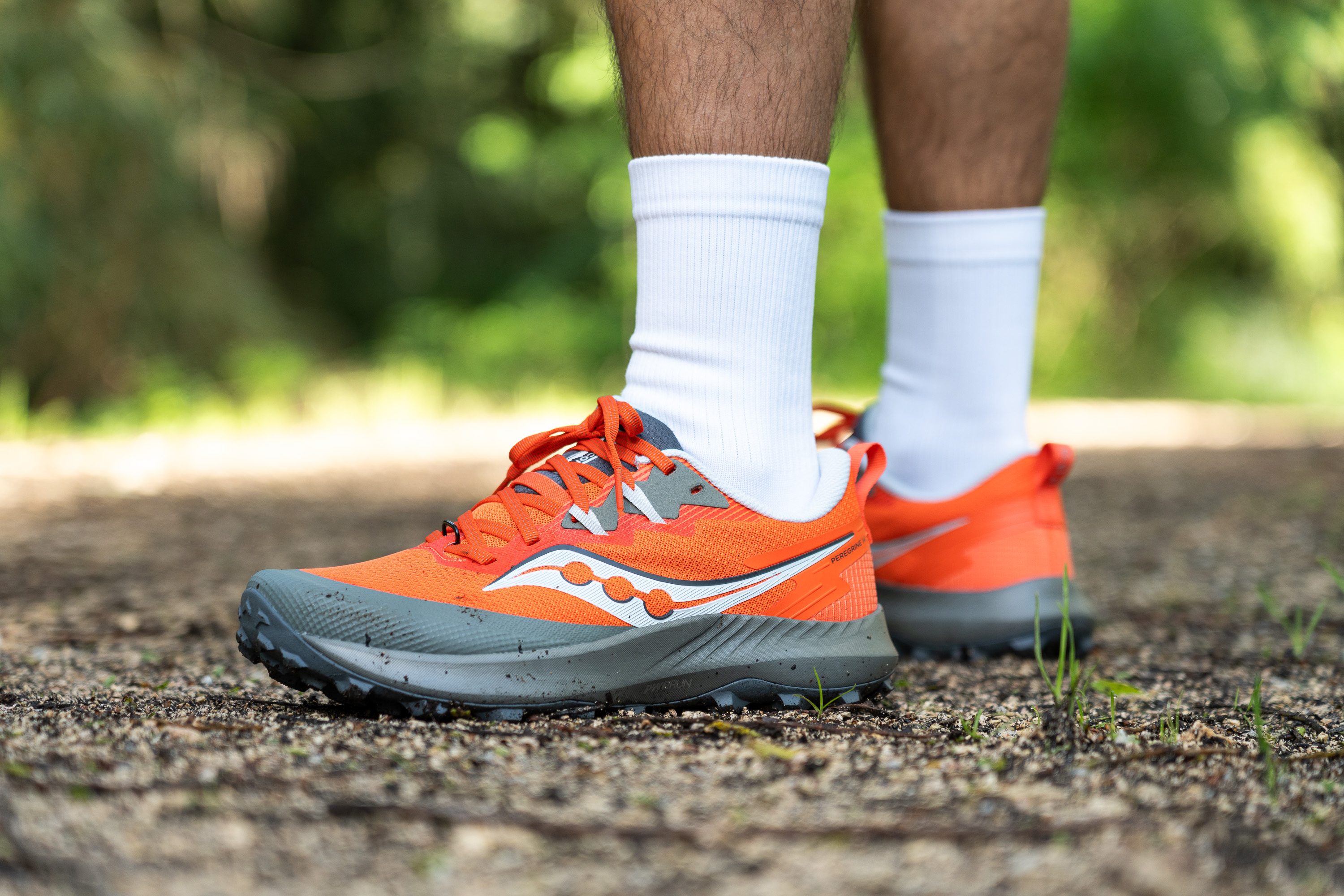
Who should NOT buy
The Saucony Peregrine 14 stands as a competent jack-of-all-trails, yet it's not without its drawbacks. From our testing, we've concluded it falls short for long distance training or competitions—if you love ultras, we recommend options like the Hoka Mafate Speed 4 or the Brooks Caldera 6 for their superior cushioning.
Moreover, for those targeting race day, we believe the Peregrine 14 might not be the optimal choice. Within Saucony's own lineup, the Endorphin Edge, with its Carbitex plate, offers a more dynamic performance, much like the Nike Ultrafly. However, be prepared to invest a bit more for that extra energy return!

Cushioning
Shock absorption
The Peregrine 14 might look less cushioned than its rivals, but it holds its own with 115 SA in the heel and 97 SA in the forefoot. That’s largely thanks to Saucony’s extra-plush insole, which adds noticeable softness underfoot.

| Peregrine 14 | 115 SA |
| Average | 122 SA |
Energy return
Energy return is solid at 59.8% in the heel and 64.5% in the forefoot—definitely ahead of most shoes in its category. However, runners chasing peak performance might lean toward a trail supershoe instead.
| Peregrine 14 | 59.8% |
| Average | 55.6% |
Heel stack
With 27.3 mm at the heel, the Peregrine remains out of the maximalist fever that's getting all over running shoes, including those destined to trails.
In fact, if you want something more substantial and cushioned, this is not your shoe at all, get the ASICS Trabuco Max 3 instead.
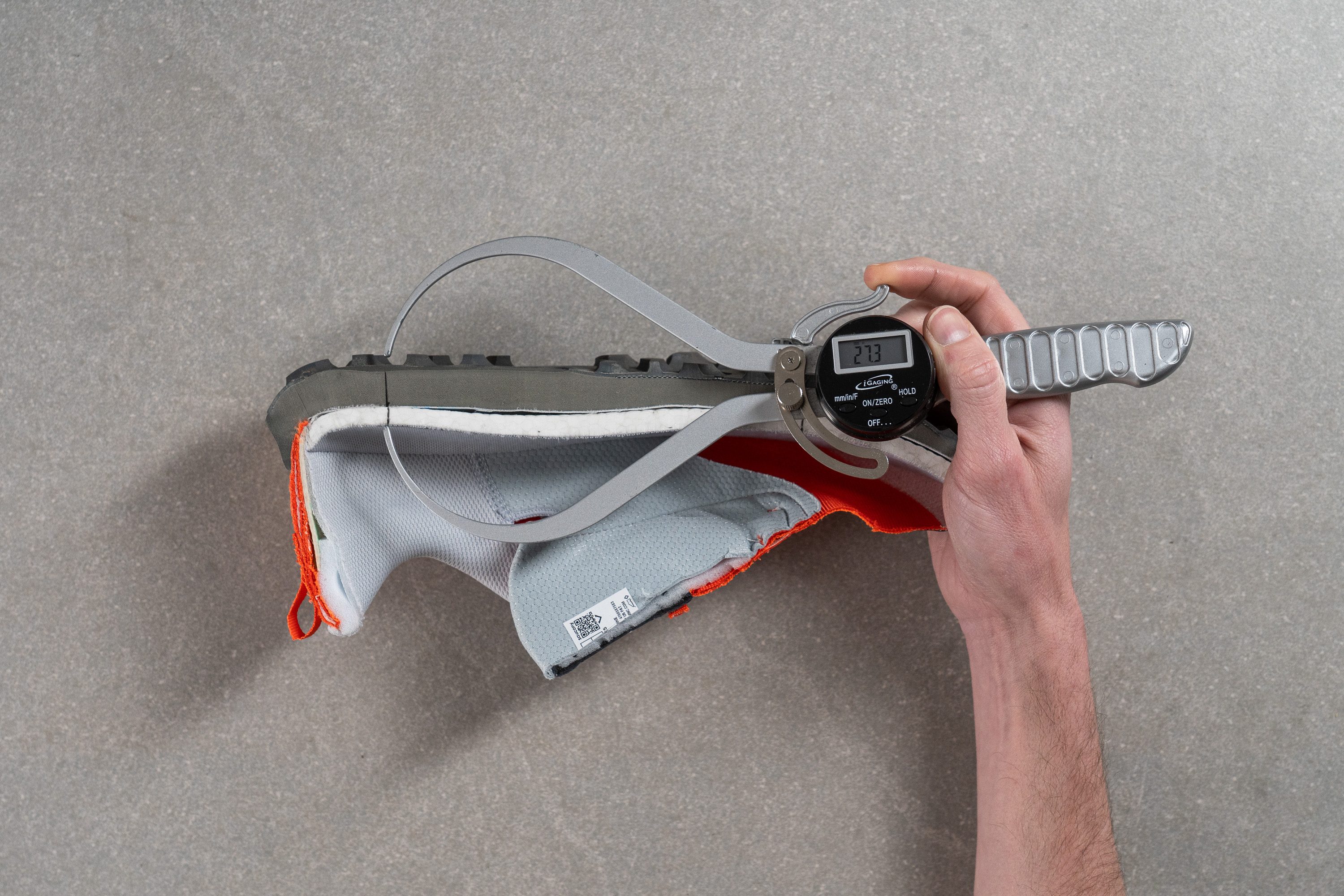
| Peregrine 14 | 27.3 mm |
| Average | 32.6 mm |
Forefoot stack
The forefoot thickness came in the lab at 25.1 mm, nearly mirroring the heel's dimension.

In our analysis, this thickness aligns more closely with the average trail running shoe. However, considering the substantial outsole and lugs, the actual cushioning it's still not that much.
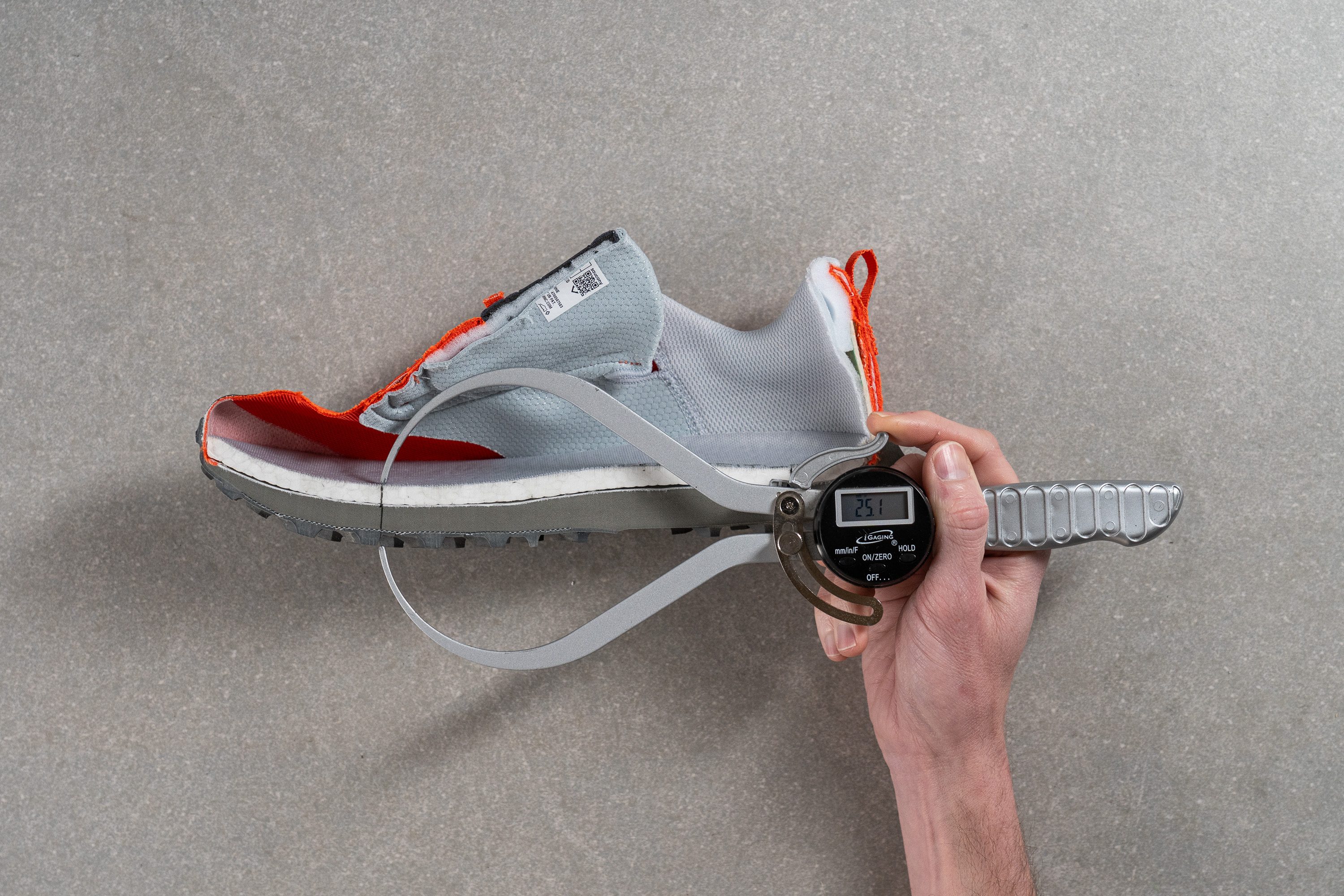
| Peregrine 14 | 25.1 mm |
| Average | 25.1 mm |
Drop
The Peregrine 14 offers a natural ride, primarily due to its minimal 2.2-mm heel-to-toe drop. We think that this feature is going to be a hit among fans of low-drop shoes or those transitioning to zero-drop footwear like Altra's offerings.
However, this characteristic might not suit extreme heel strikers, who typically prefer trail shoes with a higher drop, such as the ASICS Gel Venture 9.
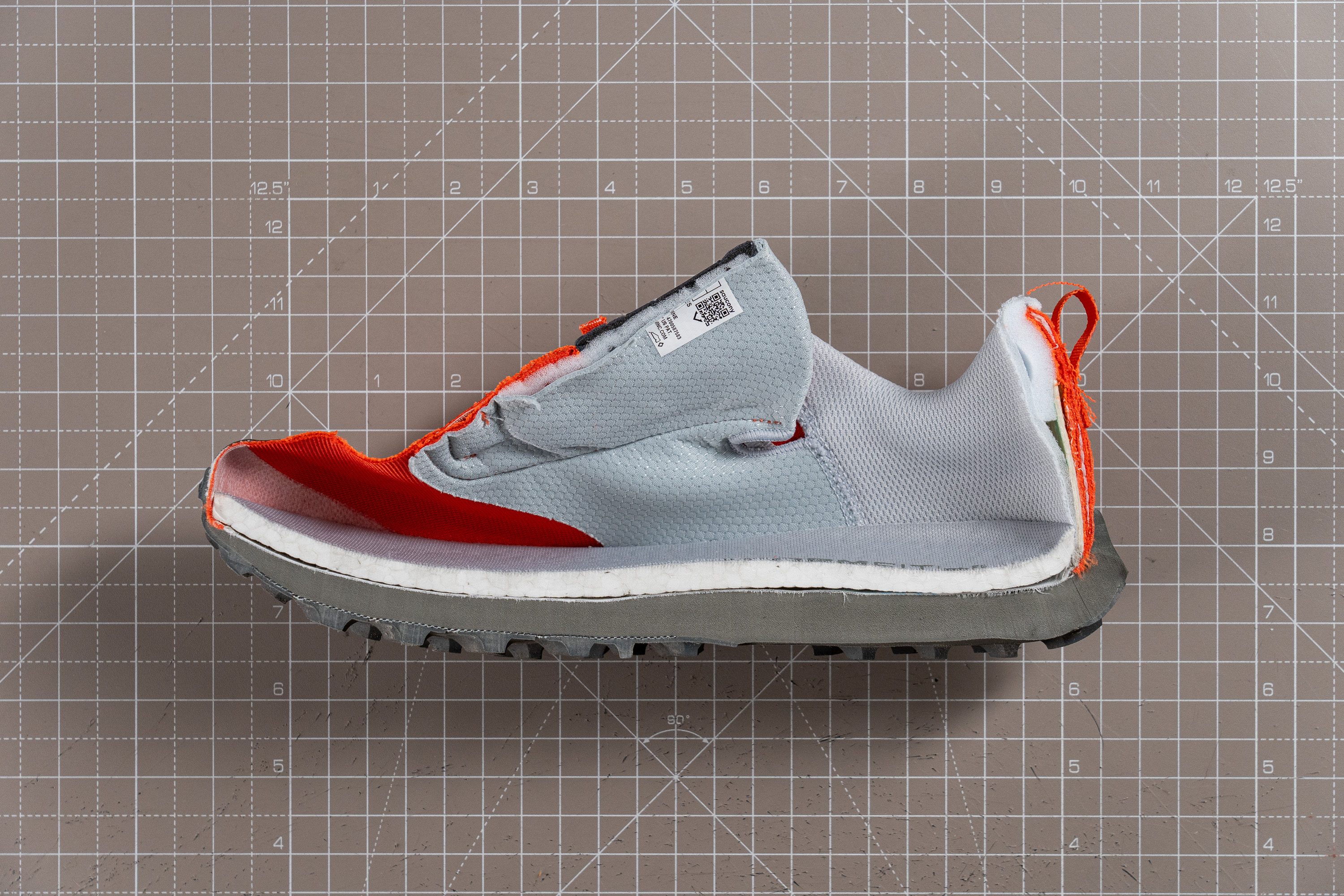
| Peregrine 14 | 2.2 mm |
| Average | 7.5 mm |
Midsole softness
In our Shore A durometer testing, the PWRRUN midsole scored a high 26.0 HA, though it was 3.1 HA softer than its predecessor.
However, coupled with the plush PWRRUN+ sockliner we revealed earlier, the midsole feel is noticeably softer underfoot. Of course, swapping the insole for a standard one shifts the experience significantly, so we encourage you to keep the included one in place unless there's no choice.
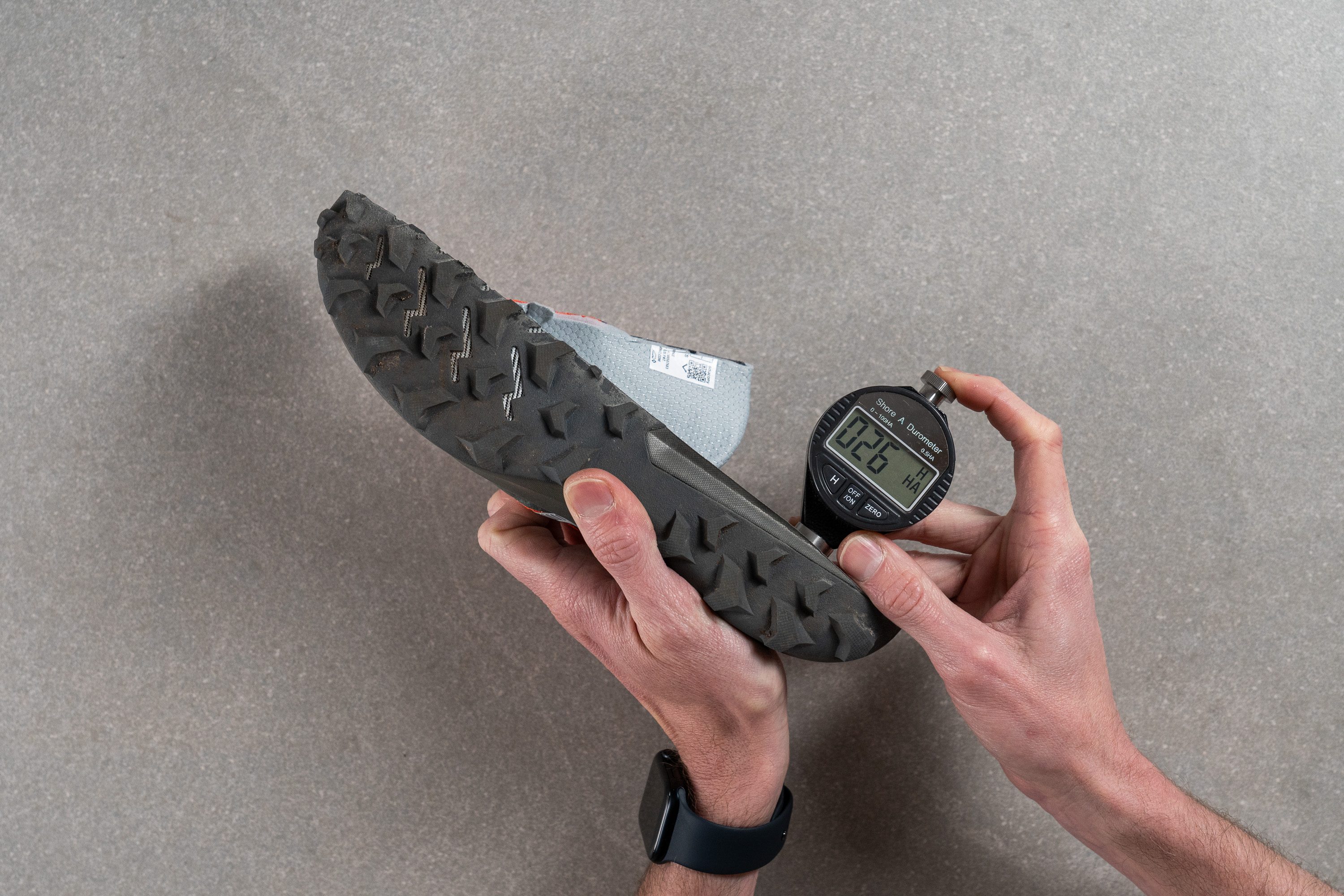
| Peregrine 14 | 26.0 HA |
| Average | 21.9 HA |
Plate
As previously demonstrated, the Peregrine 14 doesn't boast a tonne of cushioning, making the inclusion of a rock plate a wise decision.
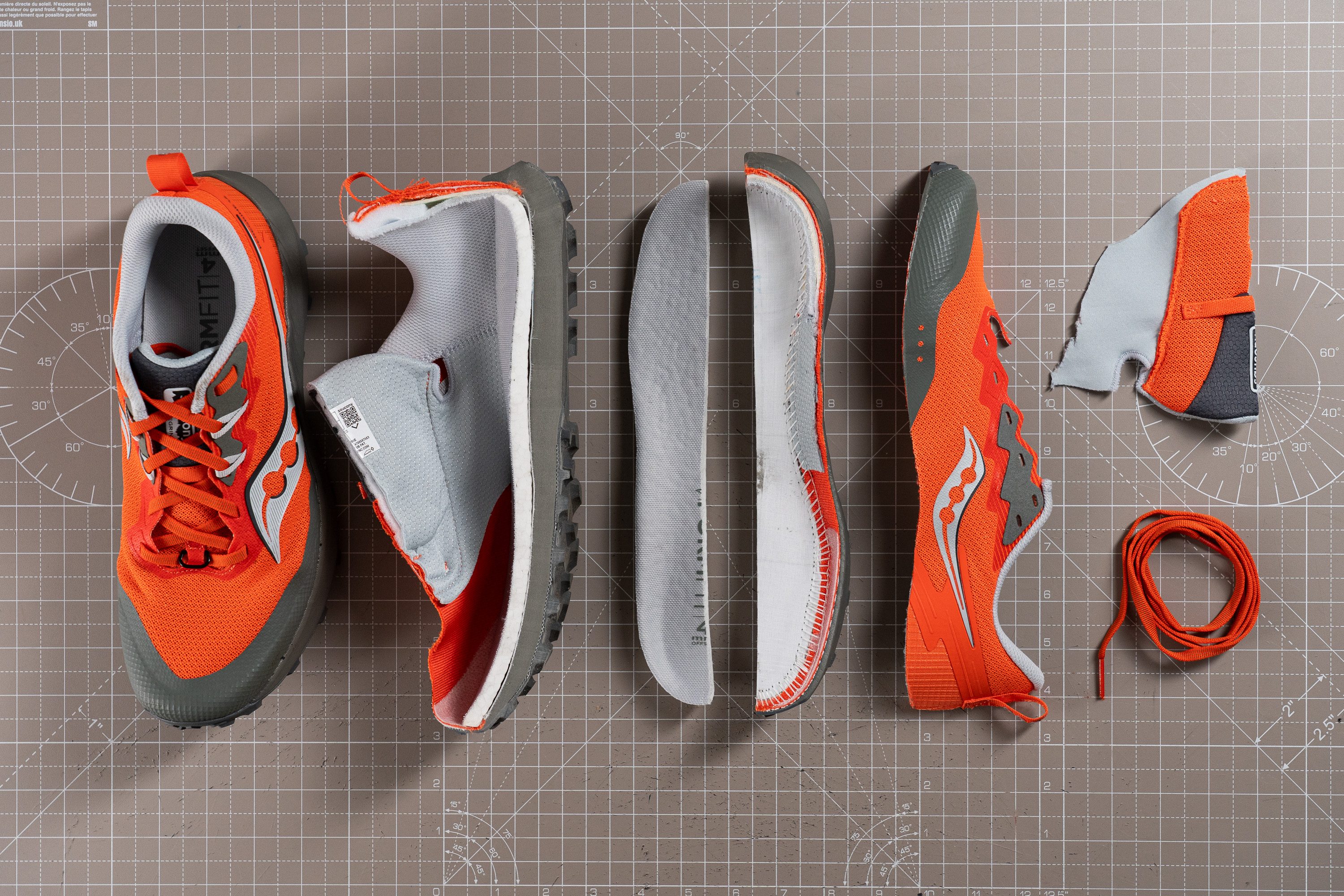
Size and fit
Size
Saucony Peregrine 14 fits true to size (42 votes).
Width / Fit
This shoe might surprise you. Despite its average or slightly narrow heel, we were delighted to find a generously roomy fit in the standard D width, with a 2E option available in select markets—a rare find in trail shoes.
Measuring at 98.4 mm, it offers more room than the v13. Keep this in mind when choosing between the two models: those with wider feet will find the latest version more comfortable, but if you have narrower feet, the previous one might be the better choice for you!
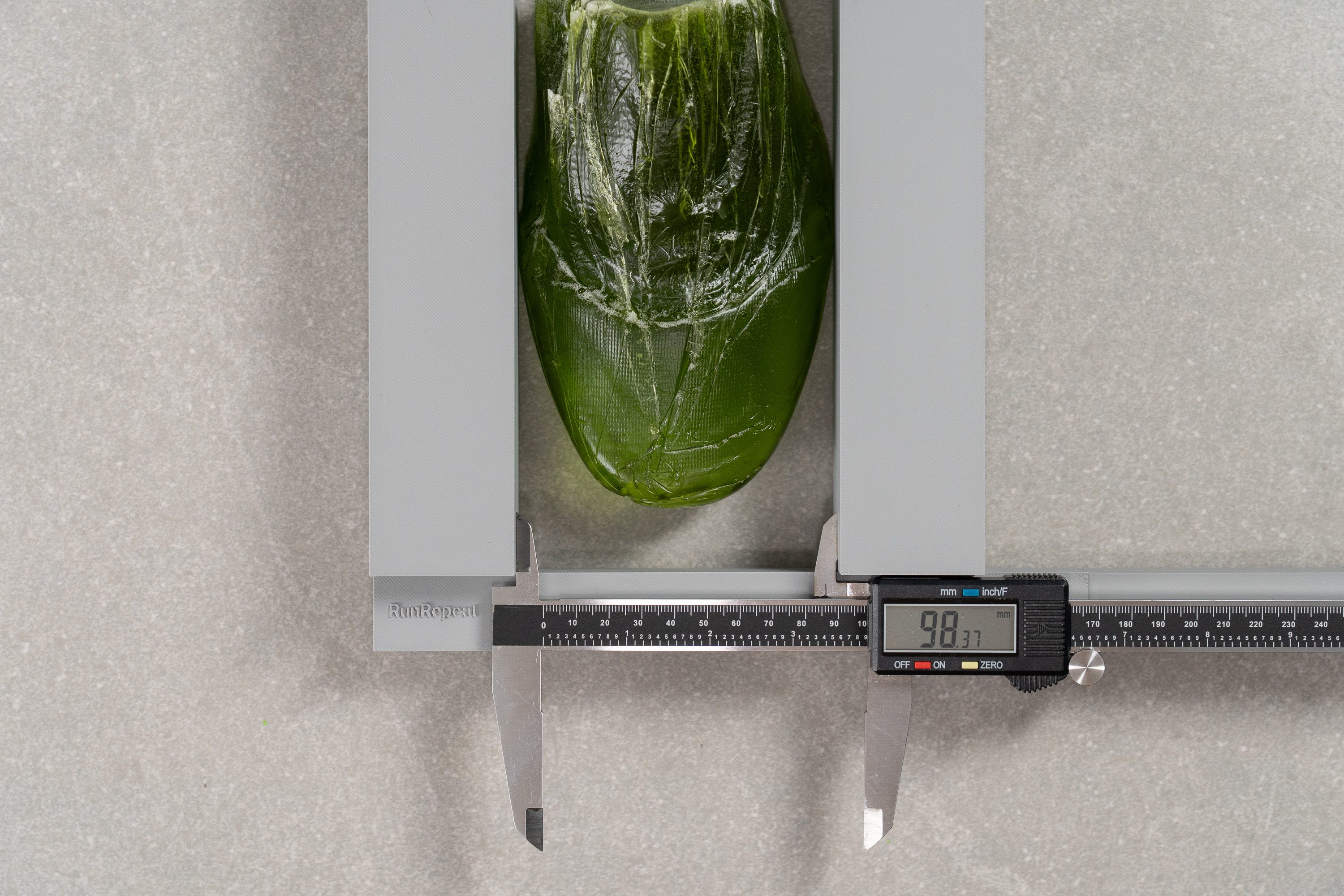
| Peregrine 14 | 98.4 mm |
| Average | 95.7 mm |
Toebox width
While the ball of the foot and surrounding areas benefit from a superior level of roominess, the same cannot be said for the toes.
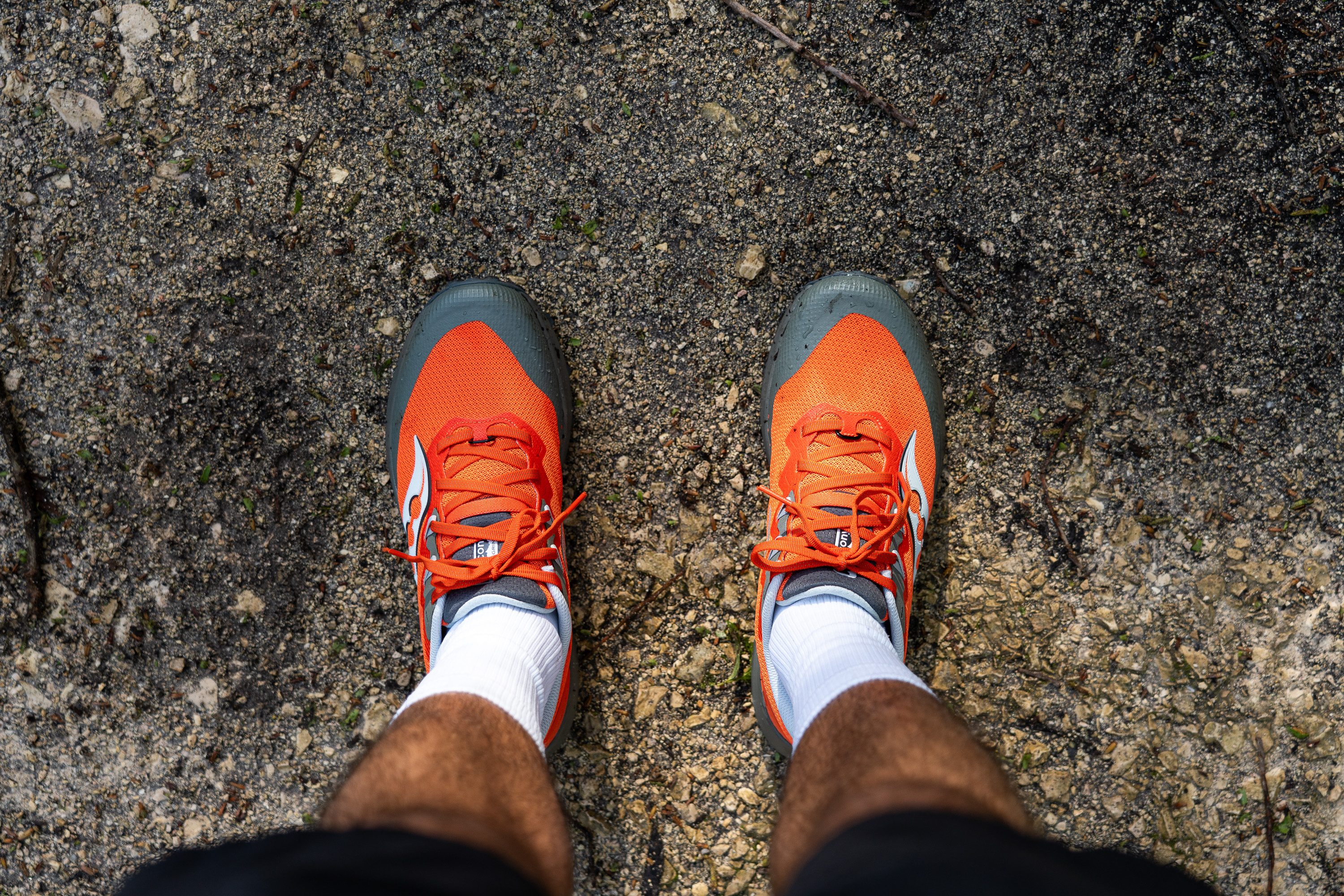
True to Saucony’s signature style, the Peregrine features a tapered design, measured here in the lab at 71.7 mm. Narrower than the average, for sure.
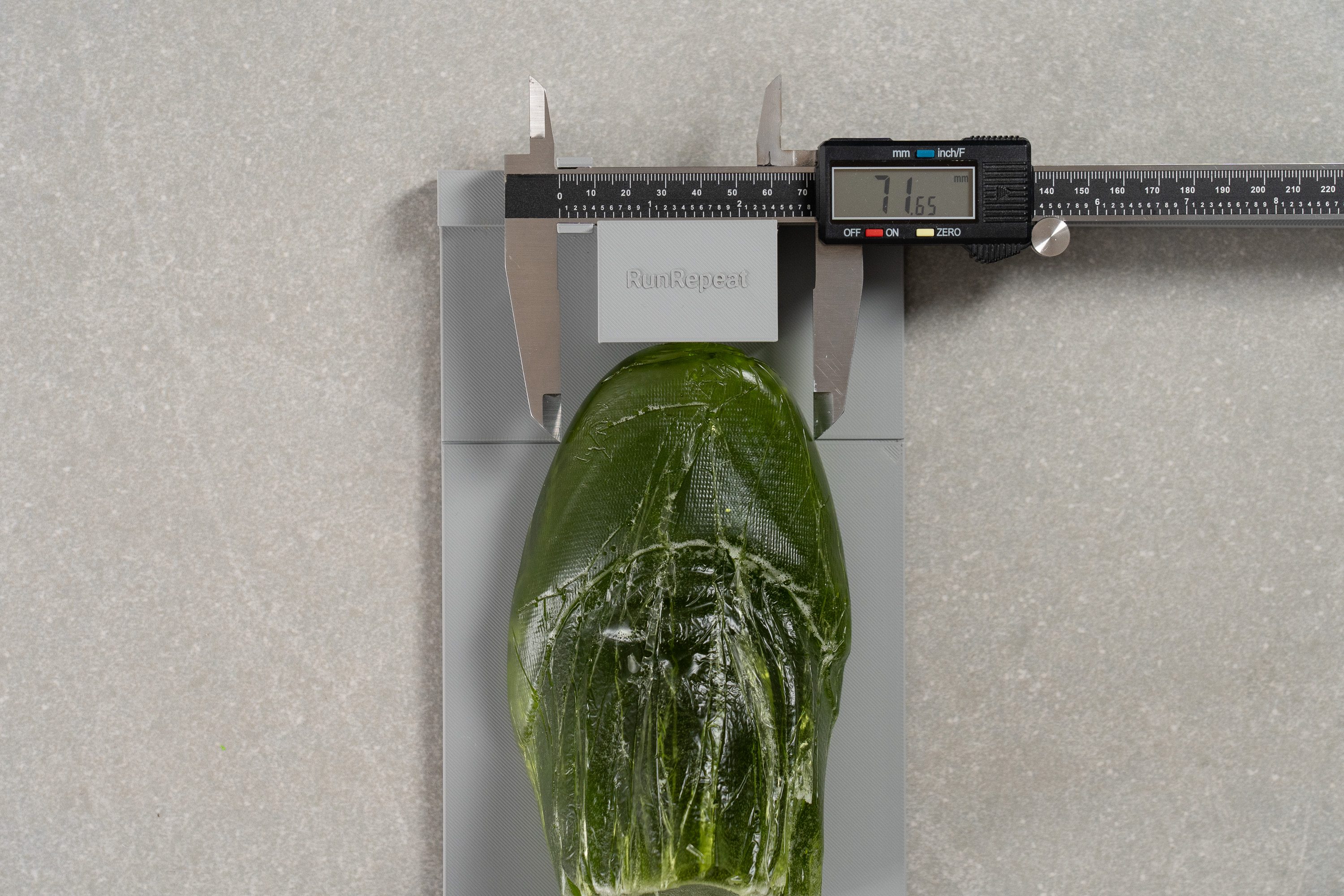
| Peregrine 14 | 71.7 mm |
| Average | 74.7 mm |
Toebox height
We found that the height in the toe area (26.4 mm) provides decent volume for upward movement, but it’s far from impressive.
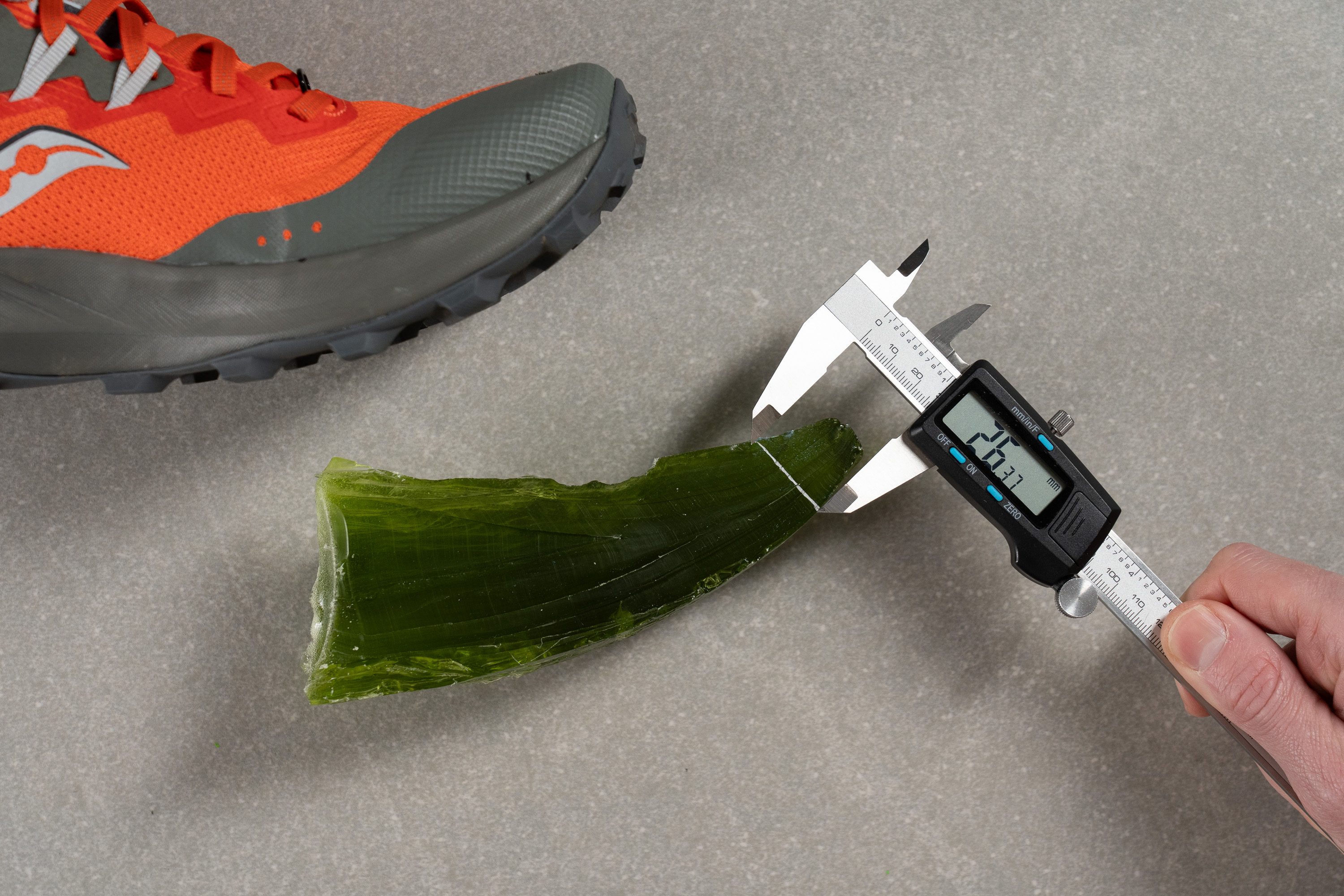
| Peregrine 14 | 26.4 mm |
| Average | 27.1 mm |
Traction / Grip
Forefoot traction
We experienced decent traction while testing the Peregrine 14, but it's still far from class-leading, especially on wet terrain. That impression was backed by our lab results, where the shoe scored 0.31, falling below the average range.
| Peregrine 14 | |
| Average | 0.60 |
Lug depth
Although Saucony advertised the lugs as being 5-mm, our meticulous measurements consistently showed them to be 4.7 mm. From our standpoint, this adjustment actually enhances the shoe's versatility, making it a welcomed change!
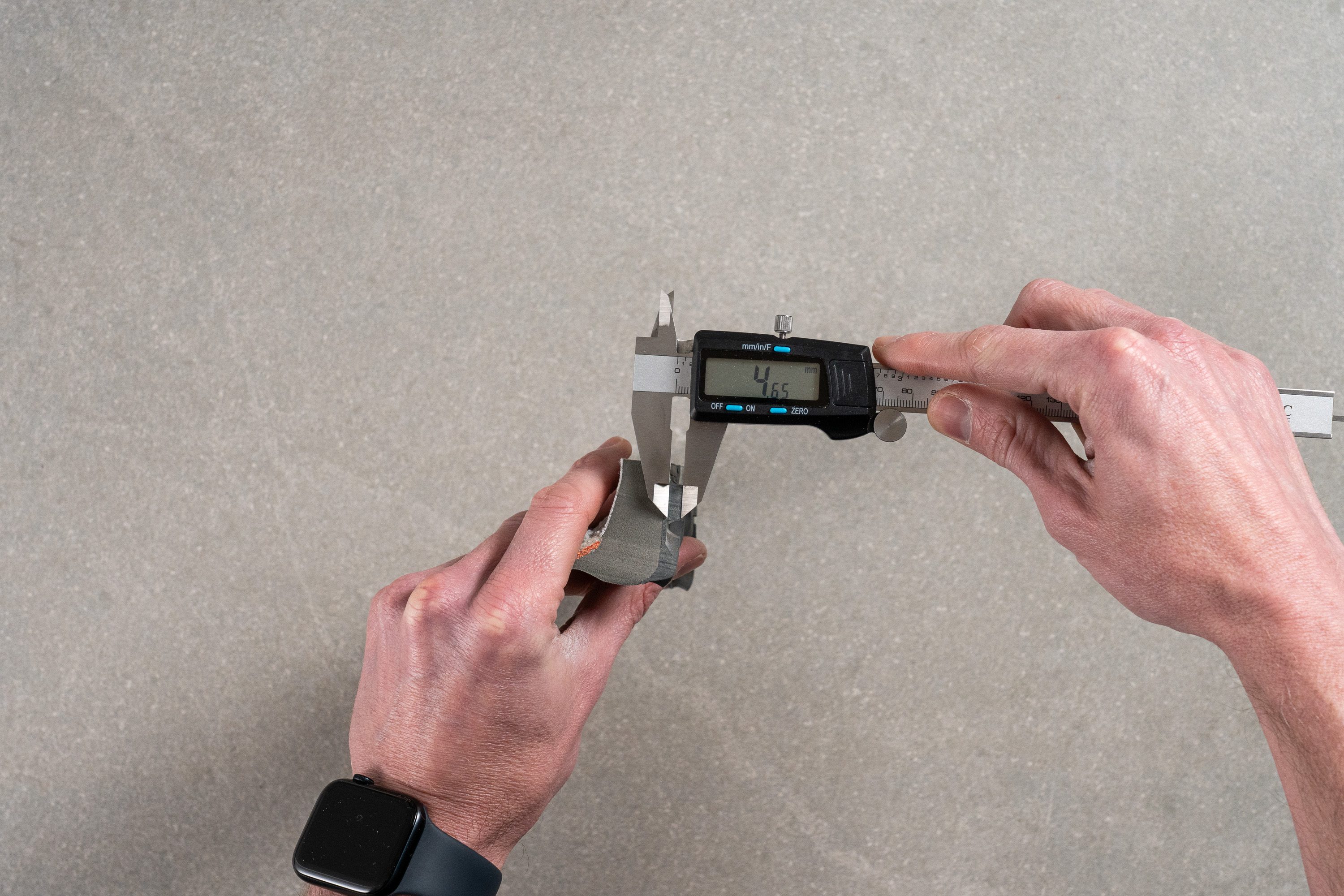
| Peregrine 14 | 4.7 mm |
| Average | 3.5 mm |
Outsole design
The Saucony Peregrine 14 features a full-length PWRTRAC rubber outsole with thick, chevron-shaped lugs covering the entire surface. A visible central groove runs longitudinally through the midfoot, enhancing flexibility. The forefoot has some cutouts and there's also a narrow channel in the heel reduces a bit of weight.

Flexibility / Stiffness
For a do-it-all trail shoe, having solid flexibility is crucial for all-day comfort across different activities. We measured 11.5N in our 30-degree bend test, a result versatile enough to handle everything from relaxed hikes to muscle-burning trail runs.
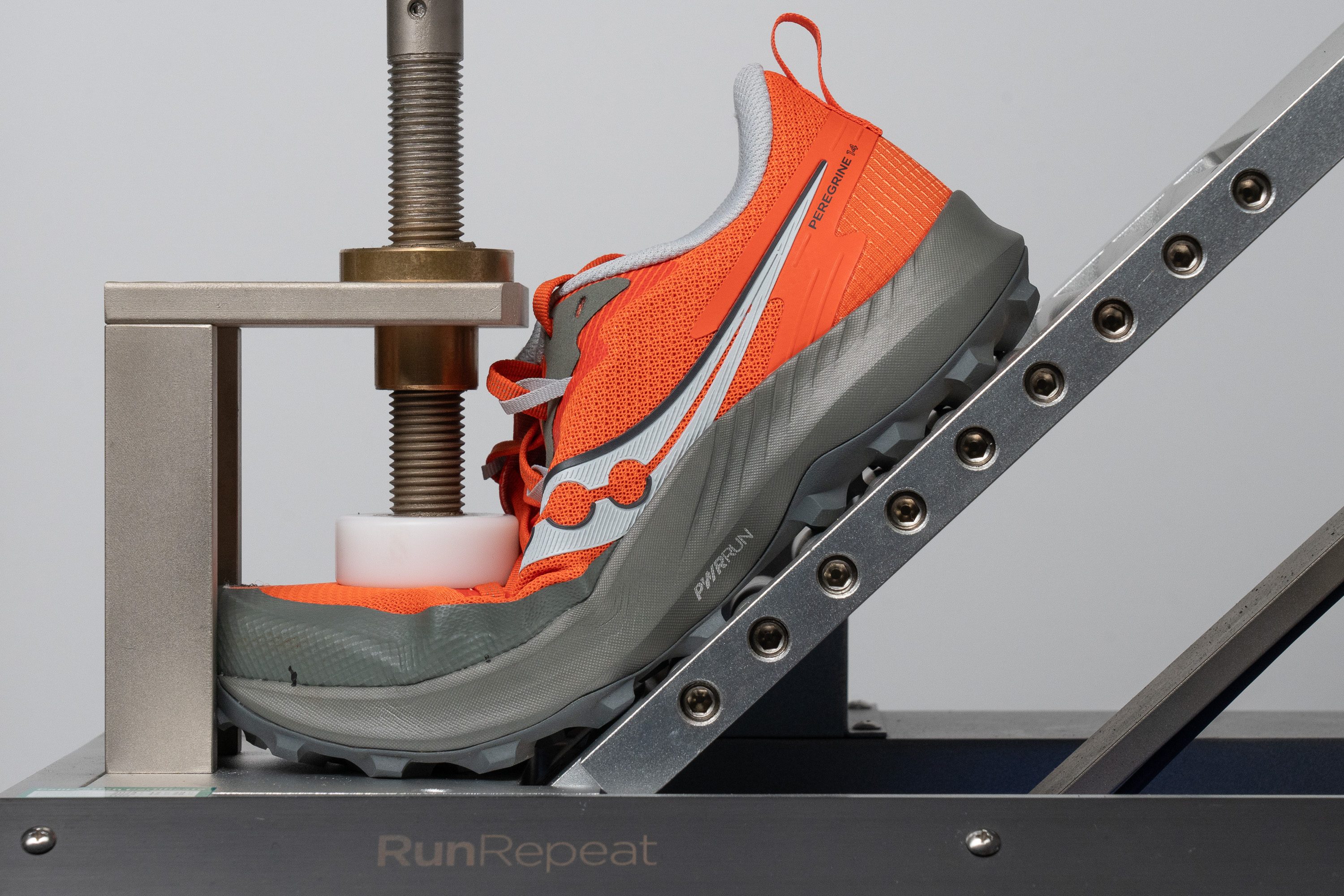
| Peregrine 14 | 11.5N |
| Average | 14.6N |
Stiffness in cold (%)
Following a 20-minute chill in the freezer, we retested the Peregrine 14 and it impressed us with only a 3.3% increase in hardness!
| Peregrine 14 | 32% |
| Average | 32% |
Weight
We've always ranked the Peregrine as a great pick for daily trail running, largely due to its versatile, sub-10-oz weight.
The v13 impressed us at 9.5 oz or 271g, and we're thrilled to see a further reduction to 9.4 oz or 266g in this latest version.

| Peregrine 14 | 9.4 oz (266g) |
| Average | 10.2 oz (289g) |
Breathability
Our initial assessment of the 14th edition of the Peregrine focused on its breathability. Given that this shoe is designed for year-round use and might be the only trail shoe in some runners' collections, we hoped for at least average ventilation.
To our relief, we discovered that Saucony incorporated sufficient ventilation into the design, earning it a solid 3/5 in our books. This rating signifies a well-balanced upper, capable of handle both winter chills and summer heat.
Placing the upper under a light and moving our hand underneath, we pinpointed the toebox as the area with enhanced airflow.
Curious about the toebox ventilation, we delved deeper using our microscope.

Our findings revealed a lack of traditional ventilation holes; however, the engineered mesh construction provides ample space for air to circulate, which we believe bodes well for the shoe's longevity.

The mesh is not only stretchy and comfortable but, at least in our view, also aesthetically pleasing. Furthermore, the upper is well-cushioned, reflecting the quality one would expect from a £140 shoe.
| Peregrine 14 | 3 |
| Average | 3.2 |
Stability
Lateral stability test
We've dubbed the Peregrine 14 a go-to daily trainer for trails, and when it comes to stability, it just hits the mark for neutral runners. We've also found it suitable for those with really subtle stability needs, similar to what you might experience with a shoe like the Nike Pegasus 40.
Torsional rigidity
One thing became clear during our review: Saucony aimed to strike a balance, steering clear of any extremes—and they nailed it!
The Peregrine truly embodies the essence of a versatile trail shoe, leading us to award it a 3/5 in our torsional rigidity evaluation.
| Peregrine 14 | 3 |
| Average | 3.6 |
Heel counter stiffness
Heel counter stiffness? Absolutely, it earned just another 3/5 from us.
Essentially, we encountered a counter akin to what you'd find in a daily road trainer—effective in enveloping the foot and providing a robust sense of stability, yet without causing any irritation or discomfort.
| Peregrine 14 | 3 |
| Average | 3 |
Midsole width - forefoot
Exploring the midsole of the Peregrine 14, we measured a balanced width of 112.3 mm.
The Peregrine aims for being good (not great) in every aspect, including agility around corners, making this sizing spot-on for its versatile intentions.
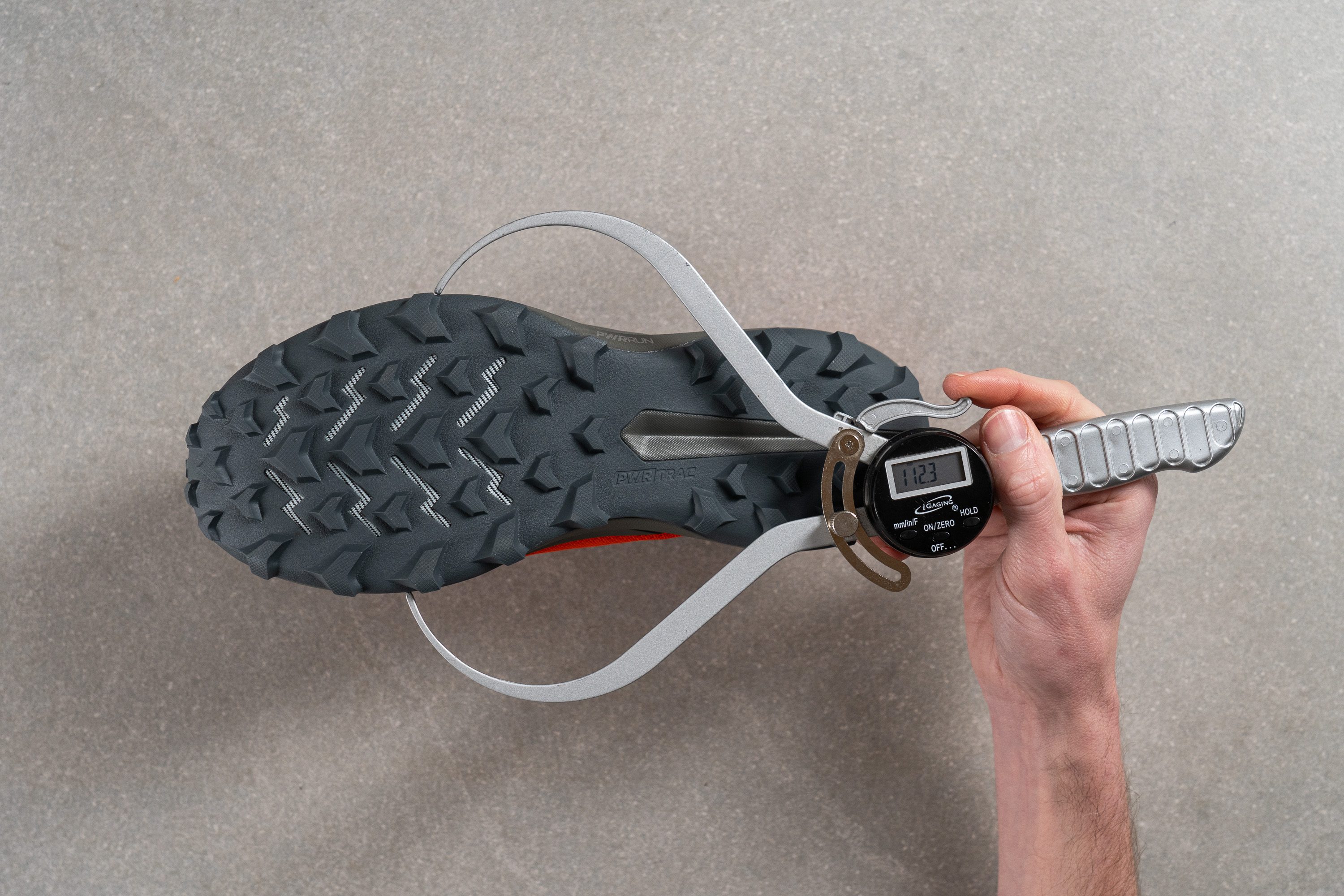
| Peregrine 14 | 112.3 mm |
| Average | 112.8 mm |
Midsole width - heel
The heel turned out to be slightly narrower than anticipated at 85.9 mm, but we soon understood the rationale.
Given its low drop and design catering to midfoot and forefoot strikers, opting for a narrower heel contributes to a more agile and lightweight shoe.
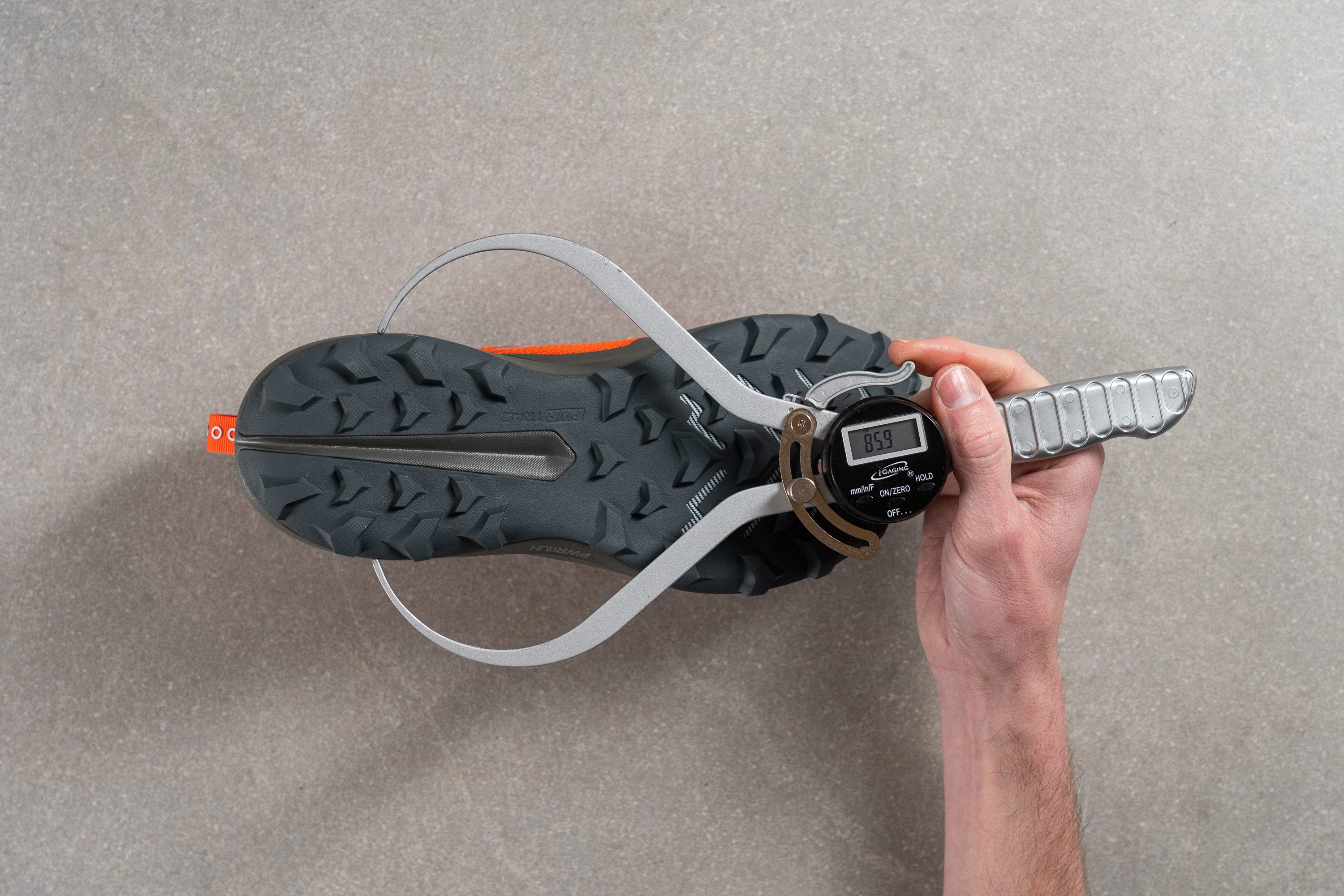
| Peregrine 14 | 85.9 mm |
| Average | 89.9 mm |
Durability
Toebox durability
The toebox, lacking typical weak spots like ventilation holes, promised at least decent durability in our Dremel test. So, we proceeded to the real test.
Applying the tool with a force of 3.2N and at a speed of 5000 revolutions per minute, we observed impressive results. The reinforced mesh with the TPU overlay held remarkably well, earning a score of 3/5 from us.

| Peregrine 14 | 3 |
| Average | 3.1 |
Heel padding durability
Next, we turned our attention to the heel padding area. While it might not seem crucial to everyone, we consider it a key component in any trail shoe.
Using the same test parameters, we discovered a score of 3/5 for the heel padding—once again, a reasonable outcome for us, though not exceptional by any means.
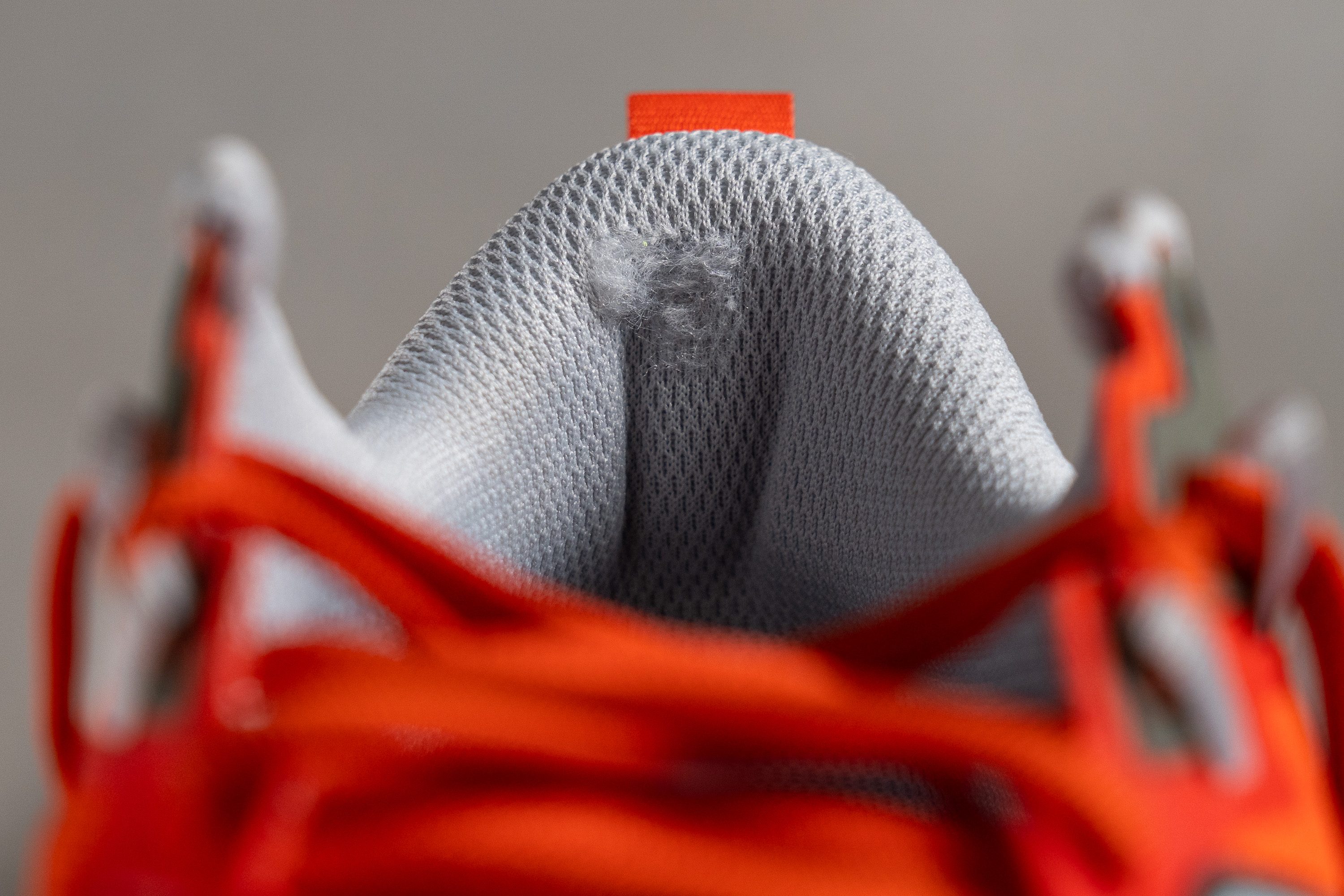
| Peregrine 14 | 3 |
| Average | 3 |
Outsole hardness
After examining the toebox and heel, we turned the Peregrine over to inspect the PWRTRAC outsole, particularly its hardness.
Our tests showed that the rubber on the Peregrine 14 is significantly harder than its predecessor's, registering at 92.4 HC compared to the 85.5 HC of the Peregrine 13. This increase clearly signals a shift towards enhanced durability.
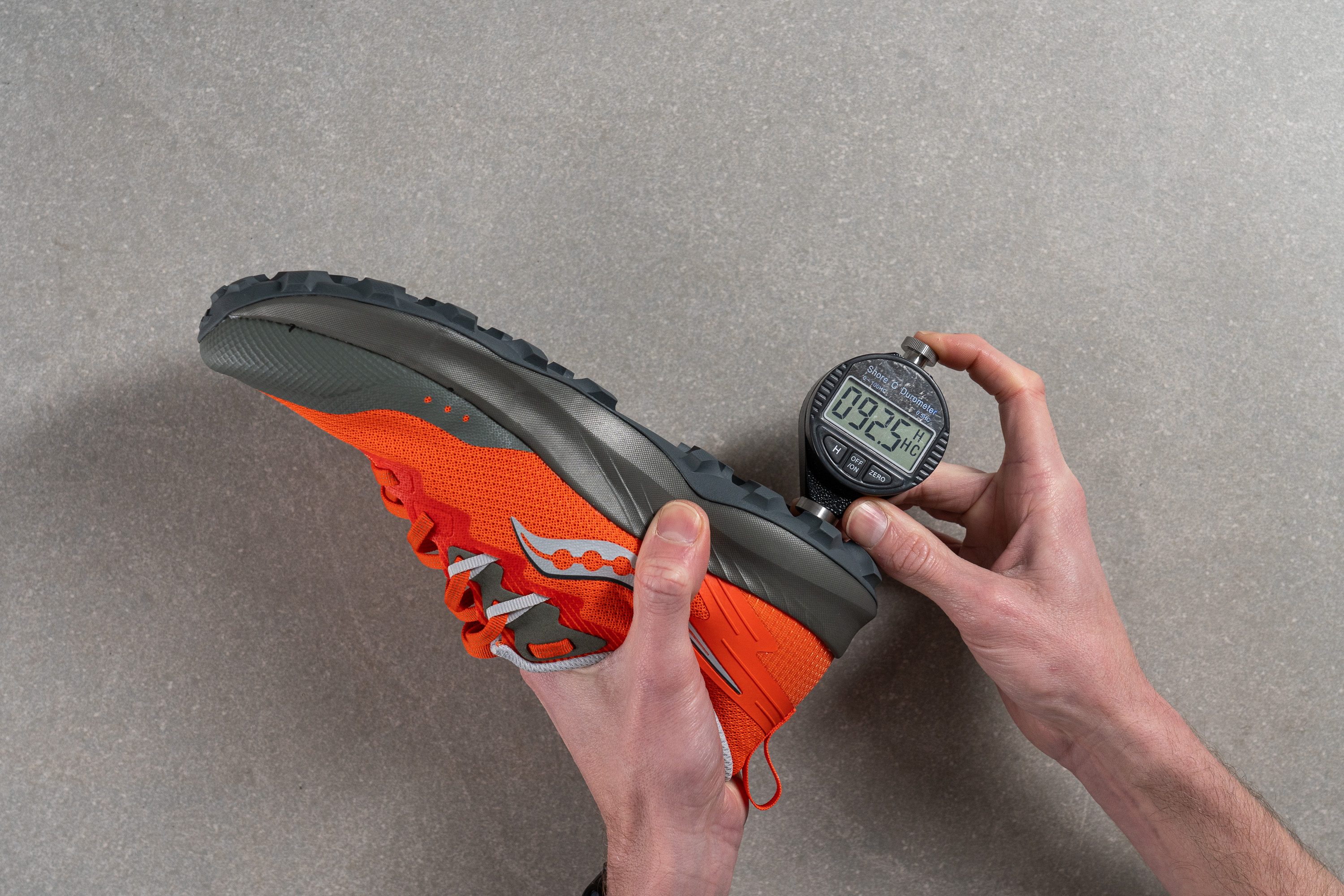
| Peregrine 14 | 92.4 HC |
| Average | 85.8 HC |
Outsole durability
In our most brutal Dremel test, we put the outsole under intense pressure. After assessing the toll taken by our tool, we observed a 0.9-mm indentation.
For a trail shoe, this might seem acceptable, but for such hard rubber, it's underwhelming. If we're compromising on grip, we at least expect stellar durability in return, and unfortunately, this is not the case here.
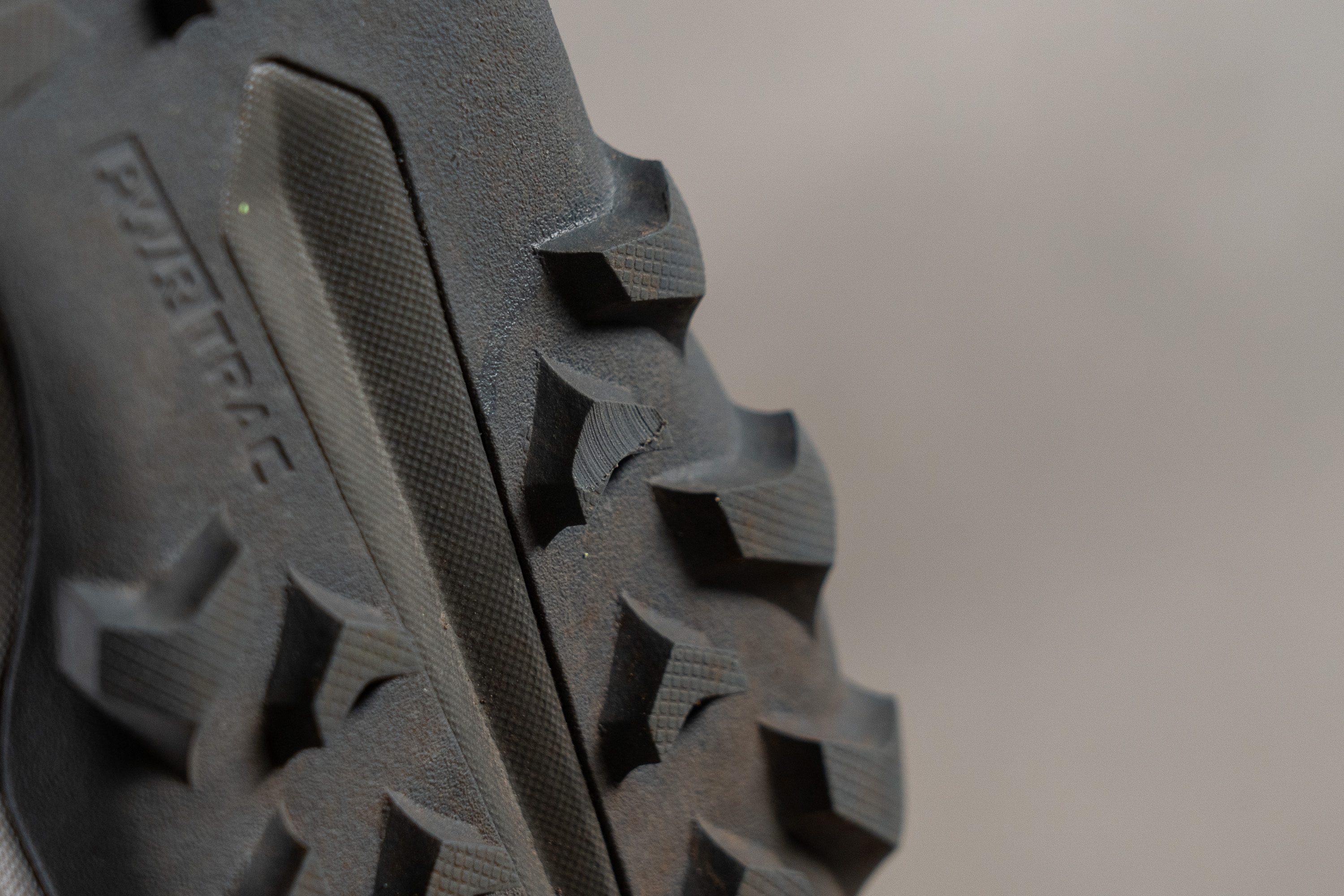
| Peregrine 14 | 0.9 mm |
| Average | 0.9 mm |
Outsole thickness
We clocked the base thickness of the outsole, excluding the lugs, at 1.9 mm, which is more than adequate for the Peregrine series. Adding any more to it would simply be a mistake.
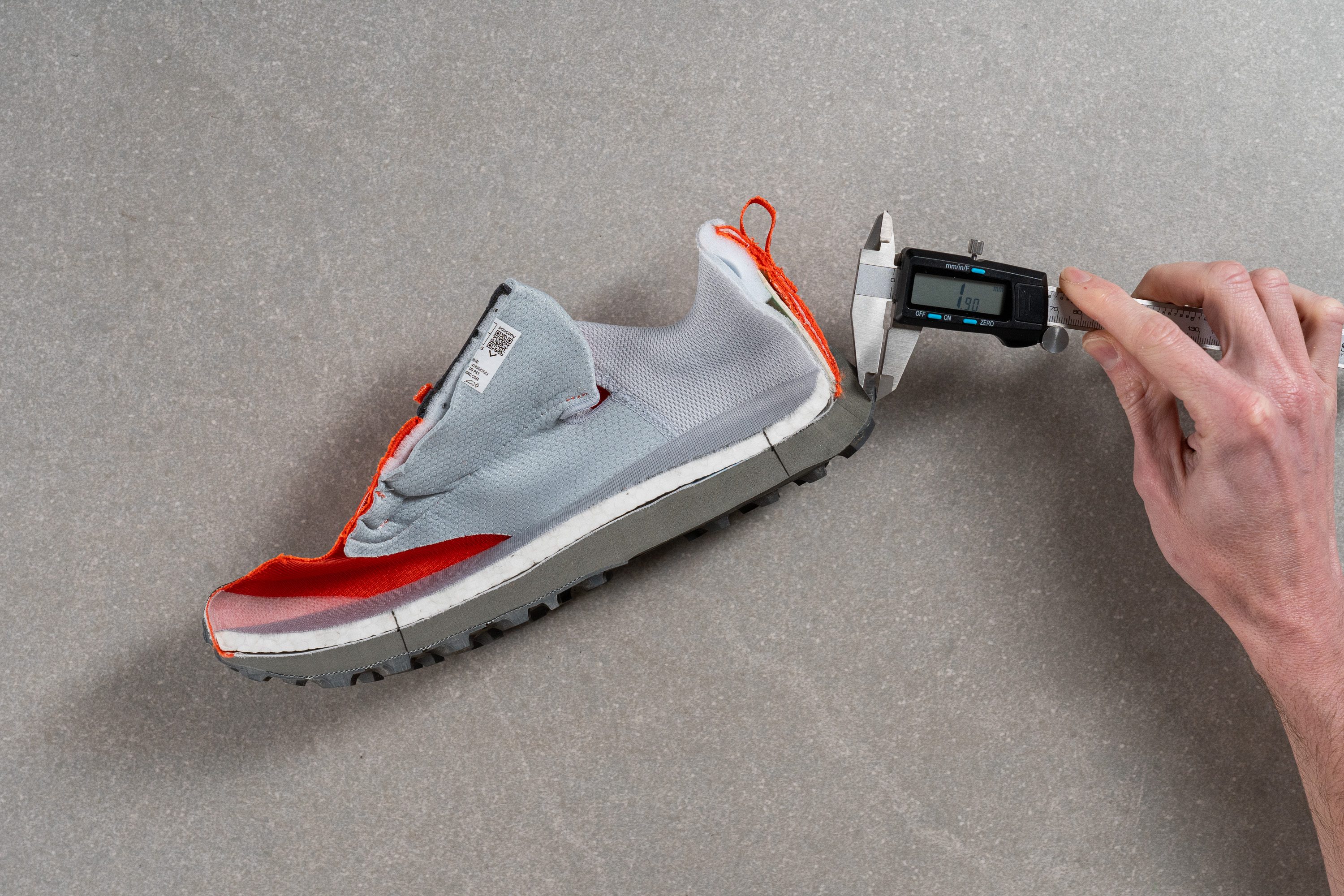
| Peregrine 14 | 1.9 mm |
| Average | 2.2 mm |
Misc
Insole thickness
In our tests, the insole of the Peregrine 14 really stood out for its incredible comfort.
With an eye-popping thickness of 6.9 mm, combined with the top-tier, TPU-based PWRRUN+ foam used by Saucony, it even outshines the shoe's own PWRRUN midsole in terms of energy return.
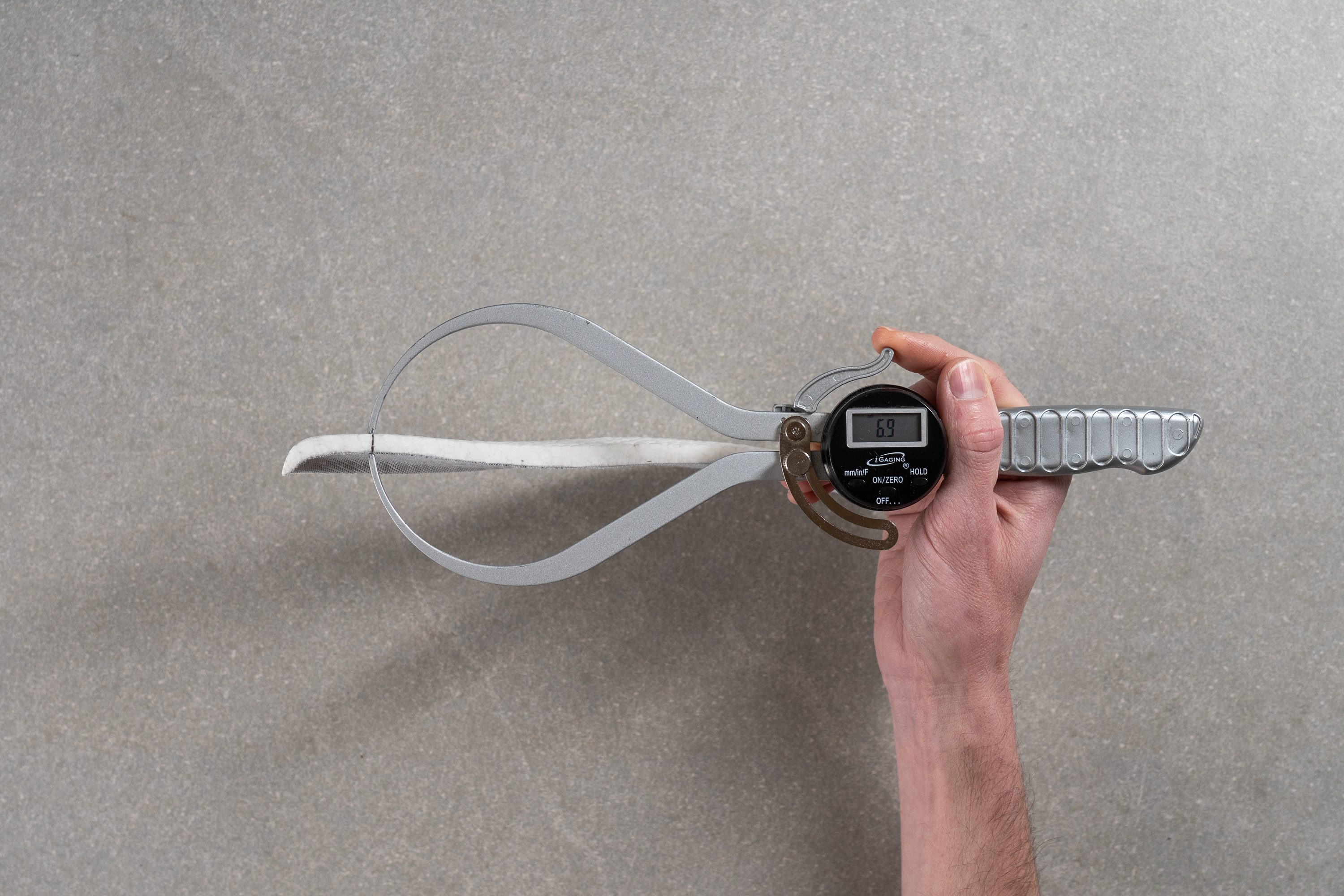
| Peregrine 14 | 6.9 mm |
| Average | 4.7 mm |
Removable insole
The insole is designed to be removable, allowing for the insertion of custom orthotics if needed. Yet, we suggest keeping it in place, as the PWRRUN+ foam it's made from is truly one of the shoe's standout features!

| Peregrine 14 | Yes |
Midsole softness in cold (%)
Mixing EVA with TPU, PWRRUN creates a great combo for cold weather. EVA typically stiffens in low temperatures, while TPU keeps its properties.
Our test showed a minor 13.5% firmness increase after putting the shoe for 20 minutes in the freezer, a figure we find fairly reasonable.
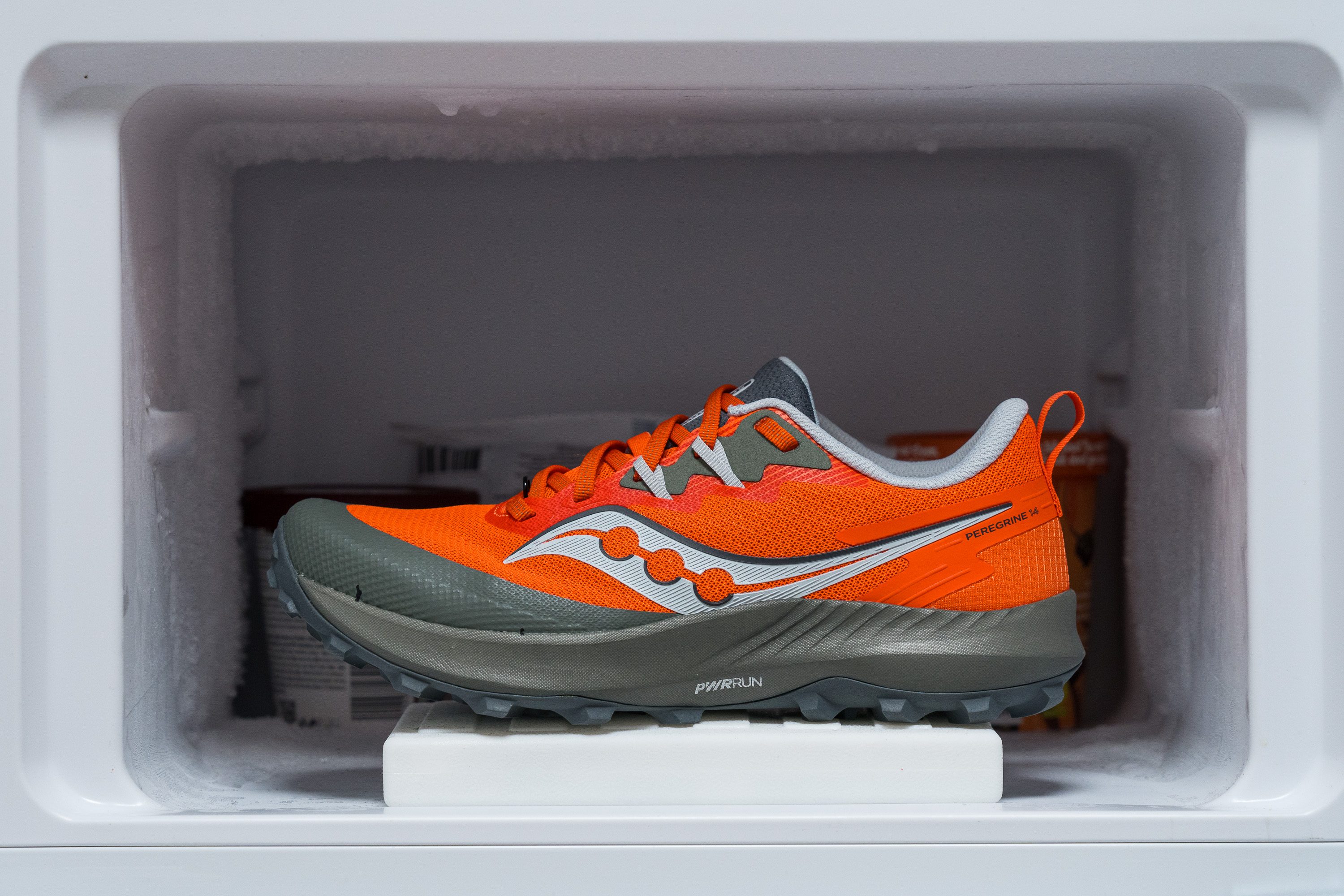
| Peregrine 14 | 14% |
| Average | 26% |
Reflective elements
The Peregrine 14 includes reflective accents for enhanced visibility and safety.
| Peregrine 14 | Yes |
Tongue padding
A common gripe with the Peregrine 13 was its thinly padded tongue, causing discomfort at the instep of some runners.

Delightfully, the new model boasts a plush 6.9 mm padding in the tongue, effectively resolving this issue while barely affecting the shoe's weight.
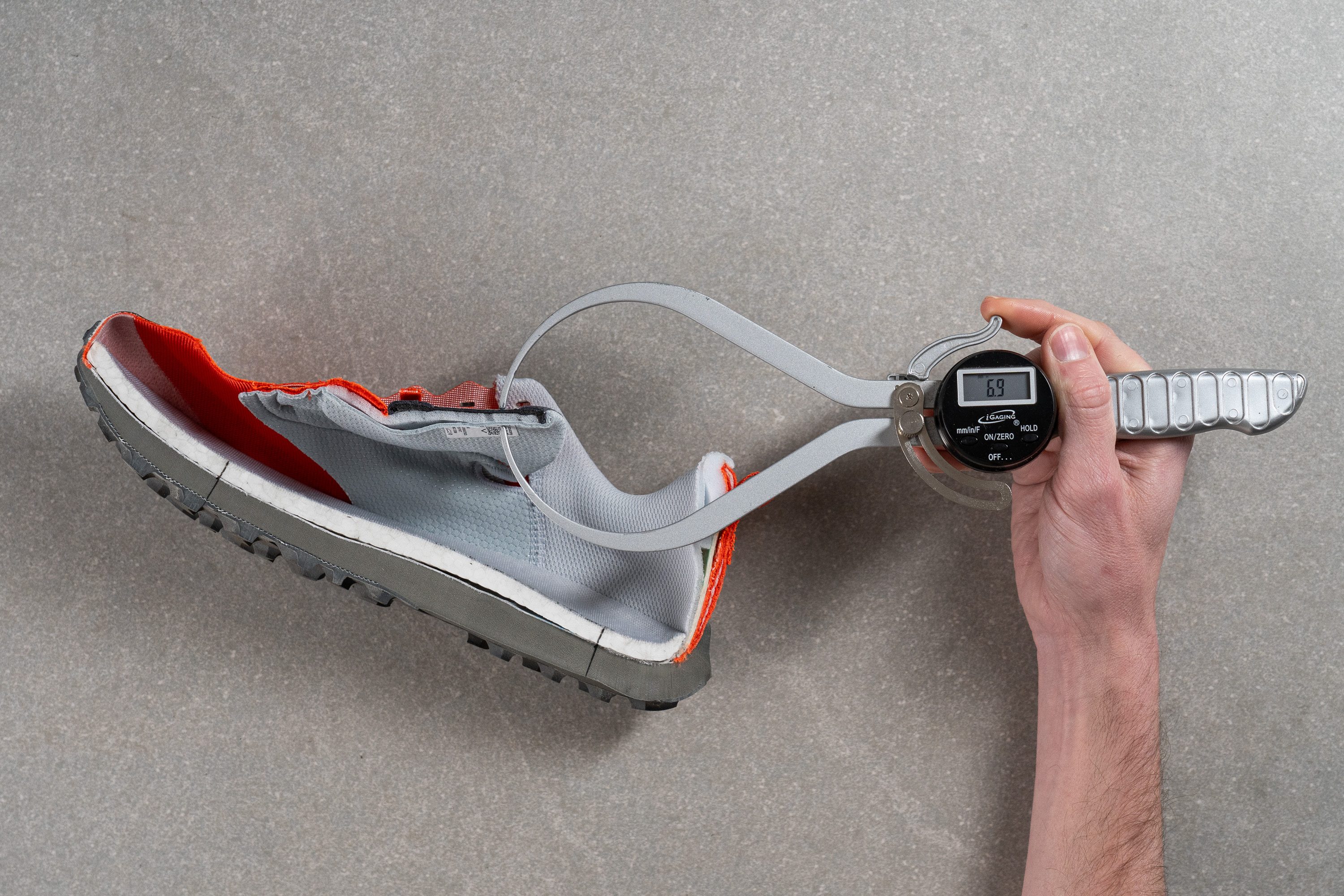
| Peregrine 14 | 6.9 mm |
| Average | 6.4 mm |
Tongue: gusset type
The semi-gusseted tongue, a standout feature in previous models for a reasonably-priced shoe, has been retained by Saucony, much to our delight.
We agree with this decision—it's a winner!
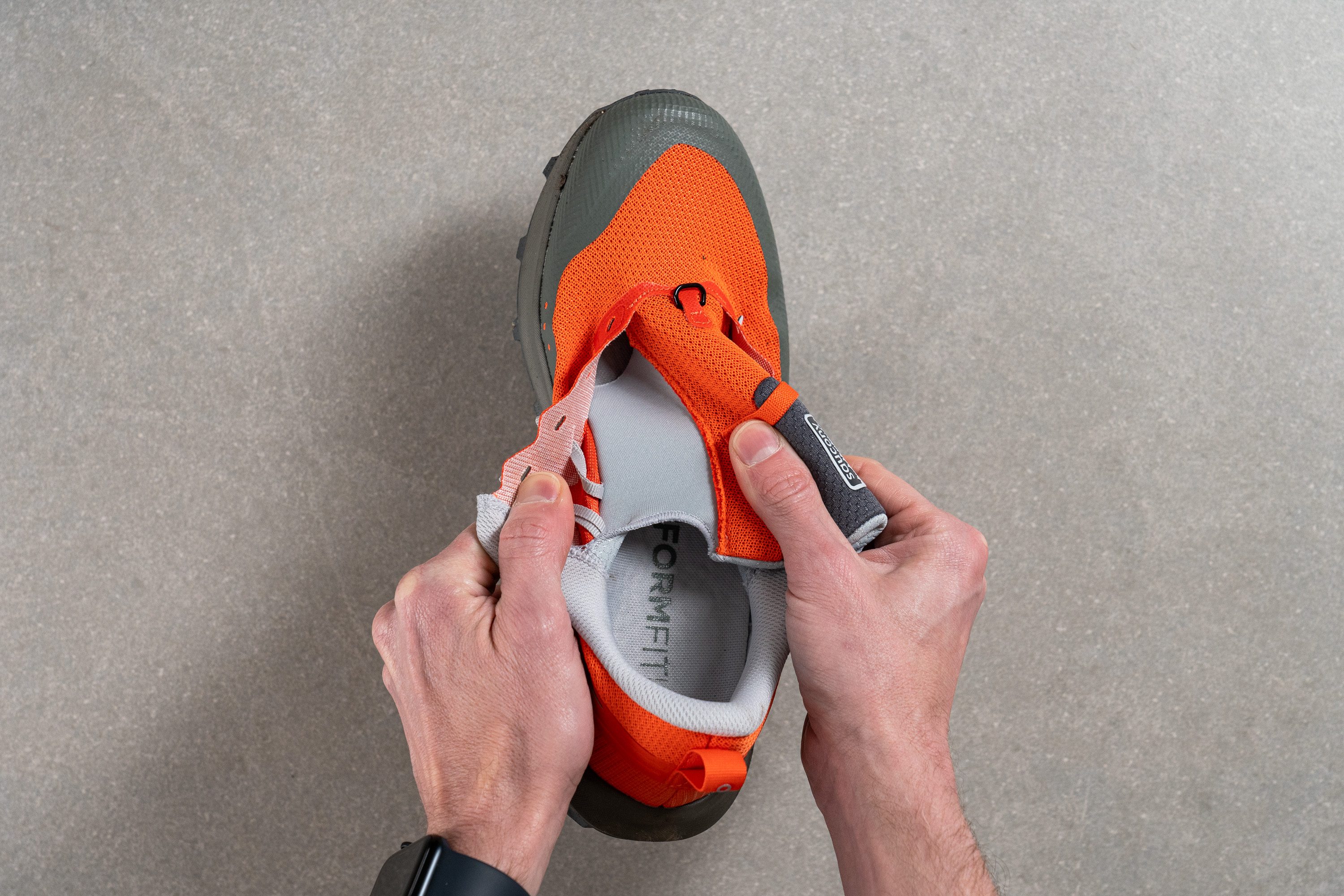
| Peregrine 14 | Both sides (semi) |
Heel tab
At the rear, we found a sleek finger-loop heel tab that looks really cool.
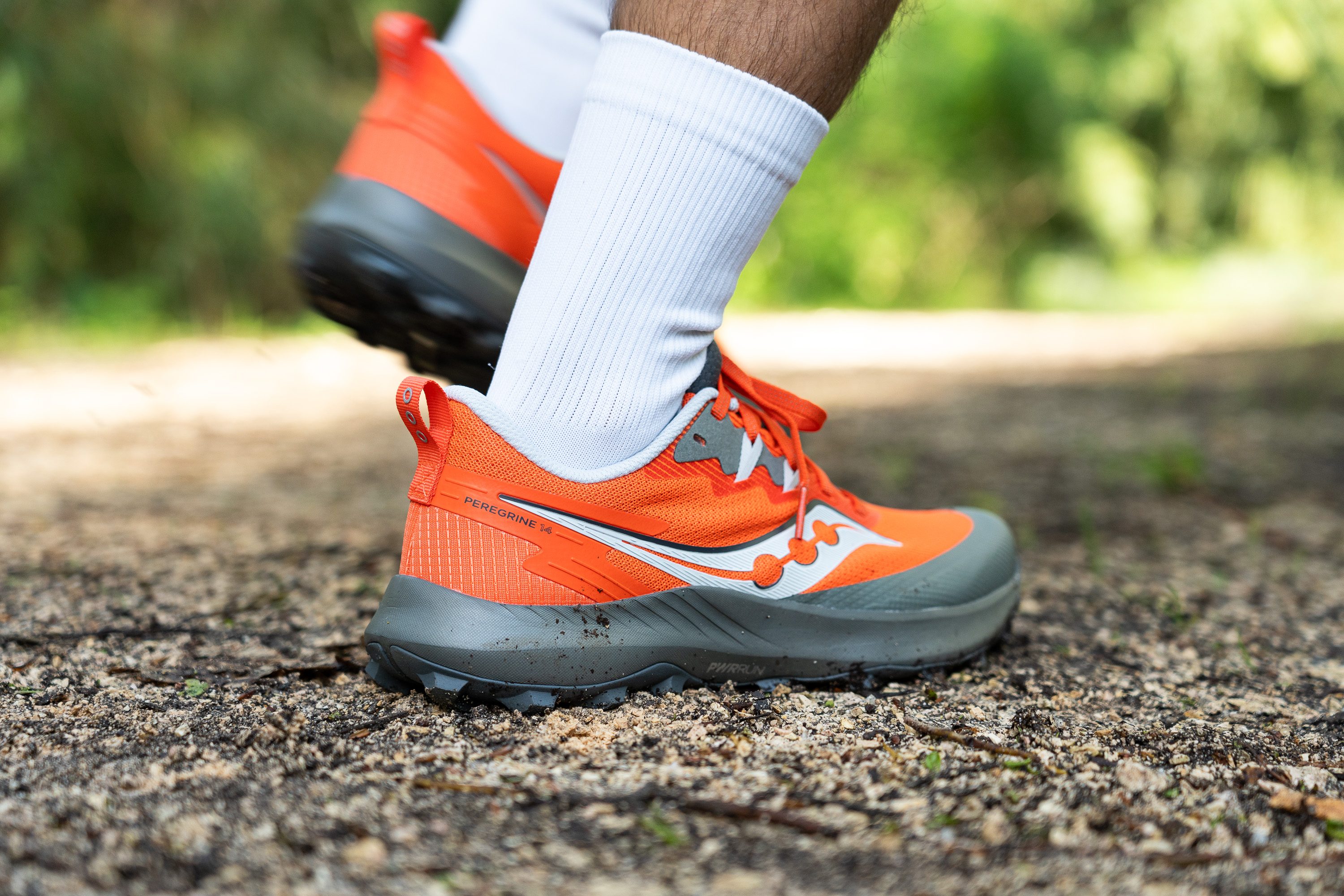
| Peregrine 14 | Finger loop |

